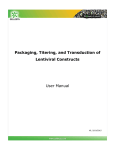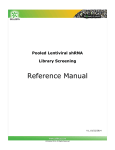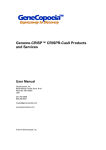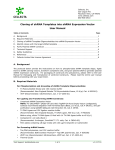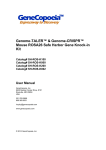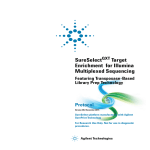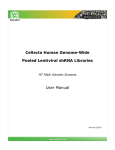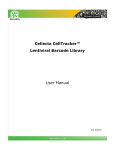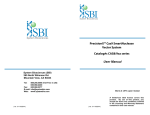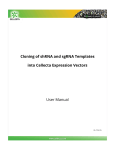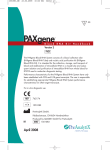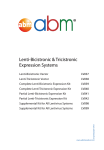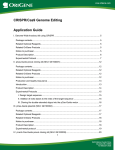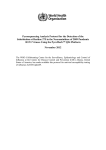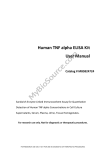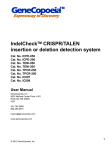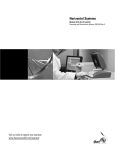Download User Manual
Transcript
Cellecta CRISPR Pooled Lentiviral Libraries User Manual Application: High-Throughput Knockout Screening with CRISPR Pooled Lentiviral Libraries v1, 7/1/2015 Cellecta CRISPR Pooled sgRNA Libraries www.cellecta.com Contents I. Introduction .........................................................................................................4 I.A. Background ........................................................................................................................................... 4 I.B. CRISPR Pooled sgRNA Library General Information ........................................................................ 5 I.B.1. Other Materials Available Separately from Cellecta .................................................................... 5 I.B.2. Required Materials Needed from Other Vendors ....................................................................... 5 I.B.3. Related Products and Services from Cellecta ............................................................................... 7 I.C. Recommended Pilot Experiments ......................................................................................................... 7 I.C.1. Doubling Time ................................................................................................................................... 7 I.C.2. Calculating a Kill Curve .................................................................................................................... 8 I.C.3. Check Toxicity of Polybrene ............................................................................................................ 8 I.C.4. Promoter Validation ......................................................................................................................... 8 II. Preparing Cas9 Expressing Cells .........................................................................9 II.A. Packaging Protocol for Cas9 Lentiviral Constructs .......................................................................... 9 II.A.1. Day 0 – Plate Cells ........................................................................................................................... 9 II.A.2. Day 1 – Transfection ....................................................................................................................... 9 II.A.3. Day 2 – Media Change ..................................................................................................................10 II.A.4. Day 3 – Collect Lentiviral Supernatant .......................................................................................10 II.B. Concentrating Virus ..............................................................................................................................11 II.C. Lentiviral Titer Estimation and Generation of Cas9 Cell Line .........................................................11 II.C.1. Transduction of Adherent Cells ...................................................................................................11 II.C.2. Alternative Transduction Protocol (Spinoculation) for Cells in Suspension ..........................12 II.C.3. Hygromycin Resistance Assay & Titer Estimation .....................................................................12 II.C.4. Generation of Cas9 Cell Line for Screens ...................................................................................13 III. sgRNA Library Packaging, Titering & Transduction ....................................... 14 III.A. Packaging Protocol for Pooled Lentiviral sgRNA Libraries ............................................................14 III.A.1. Day 0 – Plate Cells ........................................................................................................................14 III.A.2. Day 1 – Transfection ....................................................................................................................14 III.A.3. Day 2 – DNase I Treatment .........................................................................................................15 III.A.4. Day 3 – Collect Lentiviral Supernatant ......................................................................................15 III.A.5. Concentrating Virus (Optional) ...................................................................................................16 III.B. Lentiviral Titer Estimation ..................................................................................................................16 III.B.1. Transduction for Titering ............................................................................................................16 III.B.1.1. Transduction of Adherent Cells for Titering .......................................................................16 [email protected] 2 of 35 v1, 7/1/2015 Cellecta CRISPR Pooled sgRNA Libraries www.cellecta.com III.B.1.2. Alternative Transduction Protocol (Spinoculation) for Titering in Suspension Cells ....18 III.B.2. Lentiviral Titer Estimation: RFP assay ........................................................................................18 III.B.3. Calculating the PuromycinR-Titer ...............................................................................................20 III.C. Transduction of Target Cells ..............................................................................................................21 III.C.1. Number of Starting Cells and Representation .........................................................................21 III.C.2. Multiplicity of Infection ................................................................................................................22 III.C.3. Representation and Cell Propagation Techniques ..................................................................23 III.C.4. Transduction of Target Cells for Screening ..............................................................................23 IV. Loss-of-Function Screens .................................................................................. 24 IV.A. Positive Selection Screens (a.k.a. Rescue Screens) .........................................................................24 IV.A.1. Length of the Screen....................................................................................................................24 IV.A.2. MOI of Transduction ....................................................................................................................24 IV.A.3. Maintenance of the Cells.............................................................................................................24 IV.A.4. Baseline Controls for Positive Selection Screens .....................................................................25 IV.B. Negative Selection Screens (a.k.a. Viability Screens) ......................................................................25 IV.B.1. Length of the Screen....................................................................................................................25 IV.B.2. Maintaining Library Representation throughout Screen........................................................25 IV.B.3. Baseline Controls for Negative Screens ....................................................................................26 V. Identifying the sgRNA Hits in Your Screen ...................................................... 27 V.A. Genomic DNA Extraction for sgRNA (or barcode) ............................................................................27 V.B. Amplification of sgRNA (or barcodes) from Genomic DNA ...........................................................28 V.B.1. First Round of PCR .........................................................................................................................28 V.B.2. Second Round of PCR....................................................................................................................29 V.C. NGS of Pooled sgRNA (or barcodes) on Illumina NextSeq 500, HiSeq, or GAIIx ........................31 VI. Other Information ............................................................................................. 32 VI.A. Troubleshooting: Difficulties with Sample Preparation and NGS ................................................32 VI.A.1. No PCR Product ............................................................................................................................32 VI.A.2. No sgRNA (or barcodes) present in NGS results .....................................................................32 VI.B. Technical Support ...............................................................................................................................32 VI.C. Safety Guidelines ................................................................................................................................34 VI.D. References ...........................................................................................................................................35 VI.E. Terms and Conditions ........................................................................................................................35 [email protected] 3 of 35 v1, 7/1/2015 Cellecta CRISPR Pooled sgRNA Libraries I. www.cellecta.com Introduction I.A. Background The CRISPR (Clustered Regularly Interspaced Short Palindromic Repeats) and CRISPR-associated (Cas) genes denoted as CRISPR/Cas9 system is a targeted gene-editing tool adapted from Streptococcus pyogenes that enables the permanent knockout of target genes. Single Guide RNAs (sgRNA or gRNA) direct the Cas9 nuclease to a specific genomic region, upon which the Cas9 cleaves the target gene and permanently knocks it out (Figure 1). Figure 1. Guide RNA (sgRNA or gRNA) directs the Cas9 nuclease to a specific genomic region, upon which the Cas9 cleaves the target gene and permanently knocks it out. Cellecta has employed a dual-vector CRISPR/Cas9 lentiviral system for most CRISPR pooled sgRNA libraries. With the dual-vector CRISPR system, Cas9 is transduced into target cells, which are then selected for a high level of Cas9 expression. Generally, the higher the expression of Cas9, the more efficient the knockout of the target gene will be. After a population of high-expressing Cas9 cells are obtained, they are then transduced with the sgRNA library, such that most cells receive only one copy of sgRNA, thus knocking out only one target gene per cell. Upon selecting the transduced cells with a specific phenotype (e.g. cell death, cell proliferation, etc.), Next-Generation high throughput deep sequencing (NGS) of the sgRNA sequences present in the genomic DNA of the remaining cells quantifies the fractional representation of each sgRNA sequence remaining in the population. The protocols below provide the instructions on how to package the plasmid form of a pooled sgRNA library into viral particles, perform a loss-of-function screen, and prepare experimental samples for Next Generation sequencing (NGS) and analysis of raw sequencing data sets. Please read the entire user manual before proceeding with your experiment. [email protected] 4 of 35 v1, 7/1/2015 Cellecta CRISPR Pooled sgRNA Libraries www.cellecta.com I.B. CRISPR Pooled sgRNA Library General Information For specific information on the pooled sgRNA library that you have purchased, please review the Product Analysis Certificate (PAC) carefully. The PAC contains information such as: Vector sequence and map used Primer sequences required for sgRNA amplification and sequencing Cloned sgRNA insert design for your library Viral concentration (for viral libraries) I.B.1. Other Materials Available Separately from Cellecta Ready-to-use Lentiviral Packaging Plasmid Mix (Cat.# CPCP-K2A). Libraries can be packaged into lentiviral particles with nearly any 2nd or 3rd generation HIV-based lentiviral packaging mix. Cellecta’s lentiviral packaging mix contains two plasmids: psPAX2 and pMD2.G, premixed in an appropriate ratio. Negative control (non-targeting) lentiviral sgRNA constructs (Custom or premade) Linearized sgRNA expression vector, for cloning individual constructs used to validate hits from your screen LentiFuge™ Lentiviral Concentration Reagent (Cat.# LFVC1) Other custom services are listed in Related Products and Services from Cellecta. I.B.2. Required Materials Needed from Other Vendors 293T/17 Cell Line (ATCC, Cat.# CRL-11268™) Dulbecco's Modified Eagle Medium (D-MEM) (1X) (Mediatech CellGro, Cat.# 15-013-CV) NOTE: ADD FRESH GLUTAMINE (1X) at the time a sealed bottle of D-MEM is opened, even if the label indicates glutamine has already been added. Glutamine in solution at 4°C has a half-life of 1–2 months, so glutamine D-MEM purchased “off-the-shelf” from a supplier is to be regarded as glutamine(-). In our experience, the addition of glutamine increases titer approximately 2-fold. If D-MEM comes supplemented with stable L-Alanyl-L-Glutamine dipeptide, addition of fresh glutamine is not necessary. 1M HEPES pH 7.2-7.6 (Mediatech, Cat.# 25-060-CI) 1M MgCl2 solution Glutamine (L-Alanyl-L-Glutamine, Dipeptide L-glutamine) (Mediatech, Cat.# 25-015-CI) Fetal Bovine Serum Puromycin D-PBS (Mediatech, Cat.# 21-031-CV) Trypsin-EDTA (Mediatech, Cat.# 15-040-CV) Polybrene (hexadimethrine bromide) (Sigma-Aldrich, Cat.# 107689) [email protected] 5 of 35 v1, 7/1/2015 Cellecta CRISPR Pooled sgRNA Libraries www.cellecta.com Proteinase K from Tritirachium album (Sigma-Aldrich, Cat.# P4850) 500 ml, 0.2 μm PES filter units (Fisher Scientific Cat.# 09-741-05 or Thermo Scientific Cat.# 569-0020) Tissue Culture Plates and Related Tissue Culture Supplies Lipofectamine™ Transfection Reagent (Life Technologies, Cat.# 18324-020) Plus™ Reagent (Life Technologies, Cat.# 11514-015) 15-ml BD Falcon screw-cap centrifuge tubes (12,000 RCF rated, PP, P:CHCl3-resistant, BD Biosciences, Cat.# 352196) Buffer P1 (50mM Tris-HCl pH 8.0, 10mM EDTA) (QIAGEN, Cat.# 19051) RNase A (QIAGEN, Cat.# 19101) Sonicator for Genomic DNA Shearing Phenol:Chloroform:Isoamyl Alcohol 25:24:1 (Sigma-Aldrich, Cat.# P3803 or P2069) DNase I, RNase-free (Epicentre, Cat.# D9905K) Titanium Taq DNA polymerase with PCR buffer (Clontech-Takara, Cat.# 639242) dNTP Mix (10 mM each) (GE Healthcare, Cat.# 28-4065-52) QIAquick PCR purification kit (QIAGEN, Cat.# 28106) QIAquick Gel Extraction Kit (QIAGEN, Cat.# 28706) DNEasy Blood & Tissue Kit (QIAGEN, Cat.# 69506) QIAmp DNA Micro Kit (QIAGEN, Cat.# 56304) Primer for sequencing sgRNA inserts in sgRNA constructs (IDT): See Library PAC PCR primers for sgRNA amplification from genomic DNA (IDT): See Library PAC NGS primers (IDT): See Library PAC PhiX Library (Illumina, Cat.# FC-110-3001) Next-Gen Sequencing Kits (Illumina): Platform GAIIx HiSeq* NextSeq 500 Kit Type Illumina Cat.# Description Sequencing FC-104-5001 TruSeq SBS Kit v5 – GA (36-cycle) Cluster Generation GD-203-5001 TruSeq SR Cluster Kit v5 – CS – GA Sequencing FC-401-3002 TruSeq SBS Kit v3 – HS (50 cycle) Cluster Generation GD-401-3001 TruSeq SR Cluster Kit v3-cbot-HS Sequencing FC-404-2005 NextSeq 500 v2 Kit * See Illumina website for information on HiSeq 2500 rapid run kits. NOTE: We currently do not support NGS of samples on the Illumina MiSeq. [email protected] 6 of 35 v1, 7/1/2015 Cellecta CRISPR Pooled sgRNA Libraries www.cellecta.com I.B.3. Related Products and Services from Cellecta CRISPR Human Genome Knockout Libraries and Human Genome-Wide shRNA Libraries Loss-of-Function Screens with Pooled sgRNA or shRNA Libraries Next-Gen Sequencing of cell pellets, genomic DNA, or xenografts from knockout screens Gene Knockdown or Knockout Validation Custom CRISPR sgRNA constructs Linearized CRISPR sgRNA expression vectors For more information, visit www.cellecta.com, email us at [email protected], or call 650-938-3910. I.C. Recommended Pilot Experiments In order to obtain reliable data from your genetic screen, we suggest appropriate planning beforehand. We recommend the pilot studies below in your cell system of choice (the cell system that will be used in your pooled library screen). Cell-type specific data from these pilot experiments would provide you more confidence in your screen results. I.C.1. Doubling Time The doubling time is the time it takes your cells to double in number. It is useful to know the doubling time of your cells so that you can plate the appropriate number for transduction with the lentiviral library. Start with cells that have already been growing for a few weeks, rather than using cells that have just been thawed from a frozen state. To calculate the doubling time, trypsinize your cells as if you were going to split them. Count them using a hemacytometer or cell counter and keep track of the number that you replate onto the cell culture plates. The starting number of cells is Xb. Propagate the cells as you normally do, replacing media as necessary. The next time they are ready to be split, trypsinize them as usual and count them again using a hemacytometer or cell counter. The number of cells at the end is referred to as Xe. The cells should be in the log phase of growth to calculate doubling time properly, so it is important to not let the cells become confluent. To calculate the doubling time, use the following formula: 𝐷𝑜𝑢𝑏𝑙𝑖𝑛𝑔 𝑇𝑖𝑚𝑒 = 𝑇(𝑙𝑛2) 𝑋𝑒 ln( ) 𝑋𝑏 where T = Time in any units For example, let’s say that on Day 0, you count 2 × 106 cells. Three (3) days later, you count the cells at 16 × 106 cells. Xb = 2 × 106 T = 3 days Xe = 16 × 106 𝐷𝑜𝑢𝑏𝑙𝑖𝑛𝑔 𝑇𝑖𝑚𝑒 = [email protected] 3(𝑙𝑛2) 16,000,000 ) 2,000,000 ln( = 3(0.69) ln(8) 2.08 = 2.08 = 1 𝑑𝑎𝑦 (time unit same as used for T) 7 of 35 v1, 7/1/2015 Cellecta CRISPR Pooled sgRNA Libraries www.cellecta.com I.C.2. Calculating a Kill Curve Cellecta’s standard Cas9 vector expresses a hygromycin resistance gene while the sgRNA library vector typically expresses a puromycin resistance gene. For some customized libraries, other selection markers may be substituted. Regardless of the which specific selection markers the plasmids contain, to successfully select cells transduced with Cas9 or the sgRNA library, you need to know the concentration of antibiotic that kills untransduced cells within a given amount of time. We recommend the following method for obtaining the “kill curve” for puromycin and hygromycin. To create a puromycin kill curve, aliquot cells in a 12-well plate at such a density so they are at 72 hours from confluence. Add puromycin at the concentration of 0 μg/ml, 0.5 μg/ml, 1 μg/ml, 2 μg/ml, 5 μg/ml, and 10 μg/ml in six different wells. Mix and place the cells at 37°C in a CO2 incubator. Grow cells under standard conditions for 72 hours, then count viable cells and determine the lowest concentration of drug that kills at least 90% of cells in 72 hours. Use this concentration at the puromycin selection step during the screen. To calculate a hygromycin kill curve, follow the same steps as for the puromycin kill curve, but use 0 μg/ml, 50 μg/ml, 100 μg/ml, 200 μg/ml, 400 μg/ml, and 800 μg/ml hygromycin in six different wells. Determine the lowest concentration of drug that kills 99% of cells in 3-5 days. Use this concentration of hygromycin at the Hygromycin Resistance Assay & Titer Estimation step. I.C.3. Check Toxicity of Polybrene Polybrene is a transduction enhancement reagent used during transduction of the pooled lentiviral sgRNA library into the target cells. Polybrene is a polycation that neutralizes charge interactions to increase binding between the lentiviral envelope and the plasma membrane. The optimal concentration of Polybrene depends on cell type and may need to be empirically determined. Excessive exposure to Polybrene can be toxic to some cells. We recommend performing a Polybrene toxicity titration before transducing your target cells. In a 12-well plate, grow cells in complete culture medium with a range of Polybrene concentrations (0 μg/ml, 1 μg/ml, 2 μg/ml, 3 μg/ml, 4 μg/ml, 5 μg/ml) for 24 hours. Then, replace old medium with Polybrene-free complete culture medium and grow cells for an additional 72 hours. Check for toxicity by counting viable cells. For your experiments, use the highest concentration of Polybrene that results in less than 10% cell toxicity compared to no Polybrene (typically, 5 μg/ml is recommended). For some cell types, you cannot use Polybrene. I.C.4. Promoter Validation If you have not used lentiviral vectors in your target cells before, we recommend a pilot experiment to determine which promoters will work best. In the pooled sgRNA libraries, the vectors have a cDNA promoter for expression of the hygromycin and puromycin resistance and for Cas9 expression. Cellecta sells pre-packaged viruses expressing different marker genes from different promoters. You can use these to determine which promoter combination will work the best for your cells. [email protected] 8 of 35 v1, 7/1/2015 Cellecta CRISPR Pooled sgRNA Libraries www.cellecta.com II. Preparing Cas9 Expressing Cells II.A. Packaging Protocol for Cas9 Lentiviral Constructs The following protocol describes the generation of pseudoviral packaged lentiviral constructs using Invitrogen’s Lipofectamine™ Transfection Reagent and Plus™ Reagent. Other transfection reagents may be used, but the protocol should be adjusted to fit the manufacturer’s protocol. The yield of recombinant lentiviral particles typically produced under these optimized conditions is between 1×106 TU/ml and 5×106 TU/ml for shRNA or sgRNA constructs. CRISPR/Cas9 lentivector has a much lower yield (approximately 1 × 105 TU/ml) because of the large size of the construct. The protocol below is for one 15-cm plate, but you may need to use multiple plates. Start growing 293T cells in D-MEM medium plus glutamine, supplemented with 10% FBS, 2 to 3 days prior to transfection. II.A.1. Day 0 – Plate Cells 1. Twenty four (24) hours prior to transfection, plate 12.5 × 10 6 293T cells in a 15-cm plate* (or 150 cm2 flask). Use 30 ml of media per plate. Disperse the cells and ensure even distribution. At the moment of transfection, the cells should have reached ~80% confluency. Increase or decrease the number of 293T cells seeded if optimal confluency is not achieved in 24 hours. Incubate at 37°C in a CO2 incubator for 24 hours. * The goal is to have the 293T cells reach 80% confluency by Day 1. You may want to calculate the number of seed cells empirically since cell counts and growth rate can vary. II.A.2. Day 1 – Transfection 2. For each construct, mix 48 μl (24 μg) of the Ready-to-Use Packaging Plasmid Mix with 24 μl (12 μg) of the Cas9 lentiviral construct and add the plasmid mixture to 2.5 ml DMEM medium without serum or antibiotics, then mix. Add 60 μl of Plus Reagent, mix, and incubate at room temperature for 15 minutes. 1 × 15-cm plate 48 μl Ready-to-use Packaging Plasmid Mix (0.5 μg/μl) 24 μl Plasmid Cas9 Lentiviral Construct (0.5 μg/μl) 2,500 μl 60 μl 2,632 μl [email protected] Component D-MEM, no FBS, no antibiotics Plus Reagent Total volume 9 of 35 v1, 7/1/2015 Cellecta CRISPR Pooled sgRNA Libraries www.cellecta.com 3. Combine 90 μl of Lipofectamine Reagent and 2.5 ml of D-MEM medium without serum or antibiotics per plate, according to the table below. Mix gently. 1 × 15-cm plate 2,500 μl 90 μl 2,590 μl Component D-MEM, no FBS, no antibiotics Lipofectamine Reagent Total volume NOTE: If making a master mix for multiple plates, we recommend making enough master mix for one extra reaction to compensate for pipette error. 4. Add the diluted Lipofectamine Reagent (from step 3) to the DNA / Plus Reagent complex (from step 2), mix gently by flicking the tube or vortexing, and incubate at room temperature for 15 minutes. 5. Add the 5 ml DNA / Plus Reagent / Lipofectamine Reagent complex (from step 4) to the 15-cm plate from step 1, and mix complexes with medium by gentle rotation. Take care not to dislodge cells from the plate. Incubate at 37°C in the CO2 incubator for 24 hours. II.A.3. Day 2 – Media Change 6. 24 hours post-transfection, replace the medium containing complexes with fresh 30 ml D-MEM medium supplemented with 10% FBS, 20mM HEPES pH7.4. Continue incubation in the CO2 incubator at 37°C overnight. II.A.4. Day 3 – Collect Lentiviral Supernatant CAUTION: You are working with infectious lentiviral particles at this stage. Please follow the recommended guidelines for working with BSL-2 safety class materials (see Safety Guidelines). 7. 48 hours post-transfection, collect the entire virus-containing medium and filter the supernatant through a Nalgene 0.2 μm PES filter to remove debris and floating packaging cells. Failure to filter supernatant could result in carry-over of cells into your lentiviral prep. NOTE: Usually, the peak of virus production is achieved at 48 hours post-transfection. Supernatant can also be collected again at 72 hours post-transfection. Replace the collected 48hour supernatant with 30 ml of fresh D-MEM medium supplemented with 10% FBS, 20mM HEPES pH7.4, and continue incubation in the CO2 incubator at 37°C for 24 hours. 8. Proceed to concentration step, or aliquot and store the non-concentrated supernatant at –80°C. Freezing and thawing usually results in a 20% loss of lentiviral titer with each cycle. Cellecta offers lentiviral packaging services. Please contact us at [email protected] or visit our website at http://www.cellecta.com/products-services/lentiviral-packaging/ for more information. [email protected] 10 of 35 v1, 7/1/2015 Cellecta CRISPR Pooled sgRNA Libraries www.cellecta.com II.B. Concentrating Virus 1. Although concentrating virus is optional, 100-fold concentration is recommended for the Cas9 construct since yield is typically low. 2. Transfer lentiviral supernatant to clear sterile centrifuge tubes. 3. (Recommended) Add Cellecta’s LentiFuge™ Viral Concentration Reagent according to the LentiFuge User Manual instructions (see Other Materials) 4. Centrifuge at 15,000 × g for at least 1 hour at 4°C. Mark the tubes to identify the location where the pellet will be. At the end of centrifugation, you may or may not be able to see a pellet; assume it is at the location of the mark. 5. Immediately discard the supernatant by aspirating. 6. Place the tubes on ice, resuspend the pellet (which may not be visible) in PBS, PBS+10%FBS, or PBS+1%BSA, make aliquots, and freeze at –80°C. 100-fold concentration is recommended (e.g. resuspend in 1 ml PBS if starting from 100 ml supernatant). II.C. Lentiviral Titer Estimation and Generation of Cas9 Cell Line Most of the commonly used mammalian cell lines can be effectively transduced by lentiviral constructs. Relative titers can vary up to 50-fold depending on the chosen cell line. For this reason, it is critical to determine the viral titer in the cells that you plan to use for the rest of the experiment. The following section uses packaged lentiviral particles for transduction into example target cells (HEK293). NOTE: Lentiviral particles should only be opened within the laminar flow hood, and should be used under biosafety Level 2 conditions. II.C.1. Transduction of Adherent Cells The following protocol has been optimized for HEK293 cells. For other adherent cell types, parameters such as media, growth surface, time of detection, etc., will have to be adjusted. Day 1 1. Quickly thaw the lentiviral particles in a water bath at 37°C. Transfer the thawed particles to a laminar flow hood, gently mix by rotation, inversion, or gentle vortexing, and keep on ice. CAUTION: Only open the tube containing the lentiviral particles in the laminar flow hood. NOTE: Unused lentiviral stock can be refrozen at –80°C, but freezing and thawing usually results in ~20% loss of lentiviral titer with each cycle. Trypsinize and resuspend HEK293 cells to a density of 1 × 105 cells/ml in D-MEM supplemented with 10% FBS and 5 μg/ml Polybrene. Aliquot 1 ml/well in a 12-well plate and add 0 μl, 1 μl, 3.3 μl and 10 μl of 100-fold concentrated Cas9 lentiviral stock to four different wells. Mix and return cells to CO2 incubator. Grow cells under standard conditions for 24 hours. [email protected] 11 of 35 v1, 7/1/2015 Cellecta CRISPR Pooled sgRNA Libraries www.cellecta.com 2. 24 hours after transduction, replace media with fresh D-MEM supplemented with 10% FBS. NOTE: It is important to accurately record the original number of cells at time of transduction, as this is critical in titer calculation. As a rule of thumb, cells should be transduced at such a density that they will become confluent in 48 hours. II.C.2. Alternative Suspension Transduction Protocol (Spinoculation) for Cells in The following protocol has been optimized for K-562 cells. For other cell types, parameters such as media, growth surface, time of detection, etc. will have to be adjusted. 1. K-562 cells are transduced using spinoculation. This is performed using multi-well tissue culture plates and a tabletop centrifuge capable of 1,200 × g and centrifugation of multi-well plates. 2. Grow K-562 cells and maintain them between 2 × 105 and 1 × 106 cells/ml. Do not let them become too dense or let the medium become yellow at any point. 3. For lentiviral library titration, K-562 cells are resuspended at 2 × 106 cells per ml in RPMI 10% FBS supplemented with 20mM HEPES pH7.4 and Polybrene 5 μg/ml. 0.25-ml aliquots are placed into each well in a 48-well plate (5 × 105 cells/well total). This cell density has proven effective for many suspension cell lines in-house at Cellecta. To each cell-containing well, add increasing amounts of lentiviral stock to be titered. For Cas9 100-fold concentrated lentiviral stock, add 0 μl, 1 μl, 3 μl, 10 μl and 33ul of 100-fold concentrated virus. Close the plate, mix by gentle agitation, wrap the perimeter with parafilm, and place the plate into centrifuge with an appropriate balance and centrifuge at 1,200 × g at 25°C for 2 hours. 4. Following centrifugation, remove plate(s) from centrifuge, carefully remove parafilm, and place in incubator. After 3 hours, feed cells with 0.25 ml additional complete medium per well (no Polybrene). 5. At 24 hours after transduction, transfer cells to a 12-well plate and add 1ml fresh RPMI 10% FBS NOTE: Use larger vessels for large-scale genetic screen transductions. Scale up all volumes accordingly. II.C.3. Hygromycin Resistance Assay & Titer Estimation 1. 48 hours after transduction, split each transduction into two halves. 2. 72 hours after transduction, add hygromycin to one of each transduced pair. Use the concentration of hygromycin calculated from the hygromycin kill curve. For HEK293 cells, we use 100 µg/ml hygromycin, but other cell lines may respond to other concentrations ranging from 50 to 800 µg/ml. 3. When you see 99% cell death in the samples containing hygromycin (usually after ~ 3-5 days) of the no-virus control pair, count the cells from all the pairs and calculate the percent transduction for each dilution: 𝑃𝑒𝑟𝑐𝑒𝑛𝑡 𝑇𝑟𝑎𝑛𝑠𝑑𝑢𝑐𝑡𝑖𝑜𝑛 = 100 ∗ [email protected] 𝑐𝑒𝑙𝑙 𝑐𝑜𝑢𝑛𝑡 𝑖𝑛 𝑠𝑎𝑚𝑝𝑙𝑒 𝑤𝑖𝑡ℎ ℎ𝑦𝑔𝑟𝑜𝑚𝑦𝑐𝑖𝑛 𝑐𝑒𝑙𝑙 𝑐𝑜𝑢𝑛𝑡 𝑖𝑛 𝑠𝑎𝑚𝑝𝑙𝑒 𝑤𝑖𝑡ℎ𝑜𝑢𝑡 ℎ𝑦𝑔𝑟𝑜𝑚𝑦𝑐𝑖𝑛 12 of 35 v1, 7/1/2015 Cellecta CRISPR Pooled sgRNA Libraries www.cellecta.com Use the virus dilution that gives 50% hygromycin-resistant cells (HR-50) as a starting point to generate the Cas9 cell line for screens. II.C.4. Generation of Cas9 Cell Line for Screens 1. To generate the best Cas9 cell line for screens, transduce the parental cell line with increasing amounts of virus corresponding to: 1x HR-50 2x HR-50 4x HR-50 8x HR-50 16x HR-50 2. 72 hours after transduction, start hygromycin selection (same concentration of hygromycin used to calculate HR-50) and grow cells under selection for 2 weeks. 3. Select the Cas9 cell sample transduced with the highest amount of virus, which yielded the highest number of cells after 2 weeks of hygromycin selection. This should ensure that you have selected the cell sample expressing the highest non-toxic levels of Cas9. Example: Amount of Cas9 virus Cells after 2 weeks of Hygromycin Selection 1x HR-50 7 × 107 cells 2x HR-50 1 × 108 cells 4x HR-50 1.5 × 108 cells 8x HR-50 1.5 × 108 cells 16x HR-50 1 × 108 cells Here, you would choose the cells treated with 8x HR-50 to expand the Cas9 cell line. (4x HR-50 and 8x HR-50 have both the highest amount of cells; 8x HR-50 has higher copy number of Cas9 than 4x HR-50). 4. Split the selected Cas9 cell line (“8x HR-50” in this case) in 3 samples, and continue selection with 1X, 2X, and 4X increases in hygromycin concentration Sample 1: Same hygromycin concentration used to calculate HR-50 Sample 2: 2x hygromycin concentration used to calculate HR-50 Sample 3: 4x hygromycin concentration used to calculate HR-50 5. After 1 week, select the Cas9 cells that survived the highest hygromycin concentration. Expand the selected Cas9 cell sample. This is the Cas9 cell line you will use in your screen. [email protected] 13 of 35 v1, 7/1/2015 Cellecta CRISPR Pooled sgRNA Libraries www.cellecta.com III. sgRNA Library Packaging, Titering & Transduction III.A. Packaging Protocol for Pooled Lentiviral sgRNA Libraries The following protocol describes the generation of a packaged CRISPR lentiviral sgRNA library using Invitrogen’s Lipofectamine™ and Plus™ Reagent. Other transfection reagents may be used, but the protocol should be adjusted to fit the manufacturer’s protocol. The yield of recombinant lentiviral particles typically produced under these optimized conditions is 1-5 × 106 TU/ml. The chart below indicates the number of 15-cm plates to use depending on the library complexity. We do not recommend scaling down the lentiviral packaging protocol due to risk of compromising the representation of the sgRNA library. Library Complexity Number of Plates to use Amount of Virus Produced 13K 5 × 15-cm plates 1.5 × 108 TU 27K 10 × 15-cm plates 3 × 108 TU 55K 20 × 15-cm plates 6 × 108 TU 1. Start growing 293T cells in D-MEM medium plus glutamine, supplemented with 10% FBS without antibiotics, 2 to 3 days prior to transfection. III.A.1. Day 0 – Plate Cells 2. Twenty four (24) hours prior to transfection, plate 12.5 × 106 293T cells in each of the 15-cm plates (or 150 cm2 flasks)*. Use 30 ml of media per plate. Disperse the cells and ensure even distribution. At the moment of transfection, the cells should have reached 80% confluency. Increase or decrease the number of 293T cells seeded if optimal confluency is not achieved in 24 hours. Incubate at 37°C in a CO2 incubator for 24 hours. * The goal is to have the 293T cells reach 80% confluency by day 1. You may want to calculate the number of seed cells empirically since cell counts can vary. III.A.2. Day 1 – Transfection 3. In a sterile 50-ml polypropylene tube, mix the Ready-to-use Packaging Plasmid Mix and the Plasmid sgRNA Library, add the plasmid mixture to D-MEM medium without serum or antibiotics, then mix. Add the Plus Reagent, mix, and incubate at RT for 15 minutes. Use the table below for the volumes to use depending on the number of 15-cm plates you are using. 5 × 15-cm plates 10 × 15-cm plates 20 × 15-cm plates 300 µl 600 μl 1,200 µl 30 µl 60 μl 120 µl 12,500 µl 25,000 μl 50,000 µl 300 µl 600 μl 1,200 µl 13,130 µl 26,260 μl 52,520 µl [email protected] 14 of 35 Component Packaging Plasmid Mix (0.5 μg/μl) Plasmid sgRNA Library (1 μg/μl) D-MEM, no FBS, no antibiotics Plus Reagent Total volume v1, 7/1/2015 Cellecta CRISPR Pooled sgRNA Libraries www.cellecta.com 4. Add Lipofectamine to the D-MEM medium without serum or antibiotics in order to make a convenient master mix according to the table below. Mix gently. 5 × 15-cm plates 10 × 15-cm plates 20 × 15-cm plates 12,000 µl 25,000 μl 50,000 µl 450 µl 900 μl 1,800 µl 12,450 µl 25,900 μl 51,800 µl Component D-MEM, no FBS, no antibiotics Lipofectamine Reagent Total volume 5. Add the diluted Lipofectamine (from step 4) to the DNA / Plus Reagent complex (from step 3), mix gently by flicking the tube or vortexing and incubate at room temperature for 15 minutes. 6. Add 5 ml of the DNA / Plus Reagent / Lipofectamine complex (from step 5) to each 15-cm plate from step 2, and mix complexes with medium by gentle rotation. Take care not to dislodge cells from the plate. Incubate at 37°C in the CO2 incubator for 24 hours. III.A.3. Day 2 – DNase I Treatment 7. At 24 hours post-transfection, replace the medium containing complexes with fresh 30 ml DMEM medium supplemented with 10% FBS, DNase I (1 U/ml), MgCl2 (5 mM), 20mM HEPES pH7.4. Continue incubation in the CO2 incubator at 37°C overnight. 8. NOTE: 1. Overnight DNase I treatment before harvesting virus does not negatively affect lentiviral titer or infectivity and helps prevent undesirable carryover of plasmid library into the virus prep. 2. Failure to change the media the day after transfection results in large carryover of plasmid (free and/or Lipofectamine-bound) in your lentiviral prep. This may cause problems with most downstream molecular biology applications, especially whenever there is a PCR step involved such as during NGS sample preparation. III.A.4. Day 3 – Collect Lentiviral Supernatant CAUTION: You are working with infectious lentiviral particles at this stage. Please follow the recommended guidelines for working with BSL-2 safety class materials (see Safety Guidelines). 9. At 48 hours post-transfection, collect the entire virus-containing medium from each plate and filter the supernatant (~600 ml) through a Nalgene 0.2 μm PES filter to remove debris and floating packaging cells. Failure to filter supernatant could result in carry-over of cells into your lentiviral prep. NOTE: Usually, the peak of virus production is achieved at 48 hours post-transfection. Supernatant can also be collected again at 72 hours post-transfection —replace the collected 48hour supernatant with 30 ml of fresh D-MEM medium supplemented with 10% FBS, 20mM HEPES pH7.4 and continue incubation in the CO2 incubator at 37°C for 24 hours. 10. Proceed to concentration step, or aliquot and store the non-concentrated supernatant at –80°C. Freezing and thawing usually results in ~20% loss of lentiviral titer with each cycle. Cellecta offers lentiviral packaging services. Please contact us at [email protected] or visit http://www.cellecta.com/products-services/lentiviral-packaging/ for more information. [email protected] 15 of 35 v1, 7/1/2015 Cellecta CRISPR Pooled sgRNA Libraries www.cellecta.com III.A.5. Concentrating Virus (Optional) Although concentrating virus is optional, it is recommended if (1) very high titer virus stock is needed to achieve desired MOI in hard-to-transduce target cells, (2) virus should be suspended in another media (besides DMEM/10%FBS) which is optimal for sensitive target cells, or (3) 18 hours posttransduction baseline control is used in your screen (to minimize problems with possible plasmid library carryover). However, because of the additional manipulation of samples, there is the added risk of contamination and loss of virus. The following protocol was optimized to concentrate virus with high recovery. The protocol assumes that lentiviral supernatant was harvested 48 hours after transfection and filtered as in step 17 above. 1. Aliquot lentiviral supernatant in clear sterile centrifuge tubes. 2. (Recommended) Add Cellecta’s LentiFuge™ Concentration Reagent according to the LentiFuge User Manual instructions. 3. Centrifuge at 15,000 × g for at least 1 hour at 4°C. Mark the tubes to identify the location where the pellet will be. At the end of centrifugation, you may or may not be able to see a pellet—assume it is at the location of the mark. 4. Immediately discard the supernatant by aspirating. 5. Place the tubes on ice, resuspend the pellet (which may not be visible) in PBS, PBS+10%FBS, or PBS+1%BSA, make aliquots, and freeze at –80°C. 100-fold concentration is recommended (e.g. resuspend in 1 ml PBS if starting from 100 ml supernatant). III.B. Lentiviral Titer Estimation The following section uses packaged lentiviral particles for transduction into example target cells (HEK293). Please note that lentiviral particles should only be opened within the laminar flow hood, and should be used under biosafety Level 2 conditions. III.B.1. Transduction for Titering Lentiviral transductions are performed by mixing cells and virus in culture media supplemented with Polybrene. For both adherent and suspension cells, transductions are initiated in suspension and carried out overnight. Adherent cells are allowed to adhere to substrate during transduction and are transduced at a cell density that allows for 2-3 population doublings before reaching confluence. Suspension cells are typically transduced at higher density than standard growth density, and then they are diluted to standard growth density 18-24 hours after transduction. III.B.1.1. Transduction of Adherent Cells for Titering The following protocol has been optimized for HEK293 cells. For other adherent cell types, parameters such as media, growth surface, time of detection, etc. will have to be adjusted. [email protected] 16 of 35 v1, 7/1/2015 Cellecta CRISPR Pooled sgRNA Libraries www.cellecta.com Day 1 1. Quickly thaw the lentiviral particles in a water bath at 37°C. Transfer the thawed particles to a laminar flow hood, gently mix by rotation, inversion, or gentle vortexing, and keep on ice. CAUTION: Only open the tube containing the lentiviral particles in the laminar flow hood. NOTE: Unused lentiviral stock may be refrozen at –80°C, but freezing and thawing usually results in a 20% loss of lentiviral titer with each cycle 2. Trypsinize and resuspend HEK293 cells to a density of 1 × 105 cells/ml in D-MEM supplemented with 10% FBS and 5 μg/ml Polybrene. Aliquot 1 ml/well in a 12-well plate and add 0 μl, 3 μl, 10 μl, 33 μl, and 100 μl of non-concentrated lentiviral stock (supernatant filtered to remove cells and cell debris, not concentrated) to six different wells. If concentrated virus is used, scale down virus volumes accordingly. Mix and return cells to CO2 incubator. Grow cells under standard conditions for 24 hours. IMPORTANT: 1. At time of transduction, it is very important to accurately record the number of cells. This is critical in titer calculation. 2. For adherent cells other than HEK293, cell density at time of transduction would have to be adjusted for optimal transduction. Cell density typically depends on cell size. As a rule of thumb, cells should be transduced at such a density such that they would become confluent in ~48 hours. Day 2 3. Between 16 to 24 hours post-transduction, replace media with fresh D-MEM supplemented with 10% FBS without Polybrene. Return cells to CO2 incubator, and grow under standard conditions for an additional 48 hours. NOTE: Avoid confluence during and after transduction. If necessary, trypsinize and replate cells. Day 4 (72 hours after transduction) 4. Detach cells from the plate by trypsin treatment, block trypsin with FBS/media, centrifuge, resuspend in 1X D-PBS, and determine the percentage of transduced (RFP-positive) cells by flow cytometry. NOTE: Attempting to determine the percentage of transduced cells by fluorescence microscopy is not recommended. It is likely to lead to inaccurate titer estimation. IMPORTANT: Flow cytometry settings to detect RFP-positive cells are the following: Excitation: 561nm (530nm laser is still acceptable), Emission: 600/20 band-pass filter, or similar (for TagRFP). 5. Proceed to Lentiviral Titer estimation (RFP assay). [email protected] 17 of 35 v1, 7/1/2015 Cellecta CRISPR Pooled sgRNA Libraries www.cellecta.com III.B.1.2. Alternative Transduction Protocol (Spinoculation) for Titering in Suspension Cells The following protocol has been optimized for K-562 cells. For other cell types, parameters such as media, growth surface, time of detection, etc. will have to be adjusted. 1. K-562 cells are transduced (“infected”) using spinoculation. This is performed using multi-well tissue culture plates and a tabletop centrifuge capable of 1,200 × g and centrifugation of multiwell plates. 2. Grow K-562 cells and maintain them between 2 × 105 and 1 × 106 cells/ml. Do not let them become too dense or let the medium become yellow at any point. 3. For lentiviral library titration, K-562 cells are resuspended at 2 × 106 cells per ml in RPMI 10% FBS supplemented with 20mM HEPES pH7.4 and Polybrene 5 μg/ml. 0.5-ml aliquots are placed into each well in a 24-well plate (1 × 106 cells/well total). This cell density has proven effective for many suspension cell lines in-house at Cellecta. To each cell-containing well, add increasing amounts of lentiviral stock to be titered. For standard 100-fold concentrated lentiviral stock, add 0 μl, 0.3 μl 1 μl, 3 μl, and 10 μl virus. Close the plate, mix by gentle agitation, wrap the perimeter with parafilm, and place the plate into centrifuge with an appropriate balance and centrifuge at 1,200 × g at 25°C for 2 hours. 4. Following centrifugation, remove plate(s) from centrifuge, carefully remove parafilm, and place in incubator. After 3 hours, “feed” cells with 0.5 ml additional complete medium per well (no Polybrene). 5. 24 hours after spinoculation, resuspend cells at 2 × 105 cells/ml in RPMI 10% FBS in the appropriate culture vessel and grow for additional 48 hours. 6. 72 hours after spinoculation, determine the percentage of transduced (RFP-positive) cells by flow cytometry. IMPORTANT: Flow cytometry settings to detect RFP-positive cells are the following: Excitation: 561nm (530nm laser is still acceptable), Emission: 600/20 band-pass filter, or similar (for TagRFP). NOTE: Determining the percentage of transduced cells by fluorescence microscopy results in inaccurate titer estimation and is not recommended. 7. Proceed to Lentiviral Titer estimation (RFP assay) below. NOTE: Use larger vessels for large-scale genetic screen transductions. Scale up all volumes accordingly. III.B.2. Lentiviral Titer Estimation: RFP assay Lentiviral sgRNA vectors that express the fluorescent protein TagRFP (excitation 560nm, emission 590nm) allow lentiviral titer estimation by flow cytometry (RFP assay) or by a combined flow cytometry/puromycin resistance assay (RFP/PuroR assay). To check lentiviral titer, we recommend always using the same cells you will use in the screen. Most of the commonly used mammalian cell lines can be effectively transduced by lentiviral constructs. Relative titers can vary up to 50-fold depending on the chosen cell line. Lentiviral titer is measured as Transduction Units/ml (TU/ml). One TU produces one integration event in target cells. When the percentage of infected cells is at or below 20%, the number of integrations is approximately equal to the number of transduced cells. However, at higher [email protected] 18 of 35 v1, 7/1/2015 Cellecta CRISPR Pooled sgRNA Libraries www.cellecta.com transduction levels, the fraction of transduced cells with multiple integrations increases, so that the percentage of transduced cells relative to integration events/cell is no longer linear. Using the chart in Figure 2 below, MOI (MOI=multiplicity of infection = integrations/cell) can be calculated with good accuracy in the range 0.2-1.5 MOI. percentage of infected cells TITER CHART 100 80 60 40 20 0 0 0.5 1 1.5 MOI (integrations/cell) 2 2.5 Figure 2. Percentage of cells infected based on Multiplicity of Infection (MOI). The percentage of infected cells should always be measured by flow cytometry (excitation=561nm, emission=600/20 for TagRFP) by counting the percentage of RFP-positive cells in the transduced cell sample. Titer is calculated according to the titer formula below: 𝑇𝑈 𝑀𝑂𝐼 = (𝑛𝑢𝑚𝑏𝑒𝑟 𝑜𝑓 𝑐𝑒𝑙𝑙𝑠 𝑎𝑡 𝑇𝑟𝑎𝑛𝑠𝑑𝑢𝑐𝑡𝑖𝑜𝑛) ∗ 𝑚𝑙 (𝑚𝑙 𝑜𝑓 𝑉𝑖𝑟𝑎𝑙 𝑆𝑡𝑜𝑐𝑘 𝑢𝑠𝑒𝑑 𝑎𝑡 𝑇𝑟𝑎𝑛𝑠𝑑𝑢𝑐𝑡𝑖𝑜𝑛) Example: IF: The original number of cells at Transduction was 100,000, and The volume of virus stock used was 10 μl, and The observed percentage of transduced (RFP-positive) cells is 25%, THEN: The calculated MOI is 0.3 (from the titer chart, Figure 2), and The titer is: 100,000 ∗ 0.3 = 3,000,000 𝑇𝑈/𝑚𝑙 0.01 Once titer is estimated, the amount of Lentiviral Stock necessary to transduce any given number of target cells at any transduction efficiency (range of 10% - 80% infected cells) can be back-calculated from the titer formula and titer chart above. Example: To transduce 20,000,000 cells at 50% transduction efficiency, with a lentiviral stock titer of 3,000,000 TU/ml, we calculated the required amount of lentiviral stock as follows: [email protected] 19 of 35 v1, 7/1/2015 Cellecta CRISPR Pooled sgRNA Libraries www.cellecta.com We calculate the required MOI to achieve 50% transduction efficiency, using the titer chart: 50% transduction efficiency = 0.7 MOI We calculate the volume of lentiviral stock required using the titer formula: 𝑇𝑈 𝑀𝑂𝐼 = (𝑛𝑢𝑚𝑏𝑒𝑟 𝑜𝑓 𝑐𝑒𝑙𝑙𝑠 𝑎𝑡 𝑇𝑟𝑎𝑛𝑠𝑑𝑢𝑐𝑡𝑖𝑜𝑛) ∗ 𝑚𝑙 (𝑚𝑙 𝑜𝑓 𝑉𝑖𝑟𝑎𝑙 𝑆𝑡𝑜𝑐𝑘 𝑢𝑠𝑒𝑑 𝑎𝑡 𝑇𝑟𝑎𝑛𝑠𝑑𝑢𝑐𝑡𝑖𝑜𝑛) 3,000,000 = (20,000,000) ∗ 0.7 (𝑚𝑙 𝑜𝑓 𝑉𝑖𝑟𝑎𝑙 𝑆𝑡𝑜𝑐𝑘 𝑢𝑠𝑒𝑑 𝑎𝑡 𝑇𝑟𝑎𝑛𝑠𝑑𝑢𝑐𝑡𝑖𝑜𝑛) 0.7 𝑉𝑖𝑟𝑎𝑙 𝑆𝑡𝑜𝑐𝑘 = 20,000,000 ∗ ( ) = 4.67 𝑚𝑙 3,000,000 III.B.3. Calculating the PuromycinR-Titer We recommend determining the fraction of RFP-positive cells (at a given MOI) that will survive puromycin selection beforehand, if puromycin selection of transduced cells is going to be performed in the screen. Although RFP and puro-resistance markers are expressed from the same promoter, not all cells expressing detectable RFP are guaranteed to be puro-resistant. A threshold of PuroR expression is required to confer puromycin resistance. Depending on cell type, such a threshold is associated with different levels of RFP co-expression. Depending on the MOI used, a different percentage of RFP-positive cells will express enough Puro R to survive puromycin selection (i.e. the higher the MOI, the higher the percentage of multiple integrants, so the higher the percentage of RFP-positive cells expressing higher levels of PuroR). In order to calculate which fraction of RFP-positive cells are going to survive puromycin selection we recommend performing the RFP lentiviral titer estimation protocol. Based on assessed titer, perform a small-scale transduction aiming at 50% infected cells: 3 days after transduction, split cells into 2 samples, grow cells with or without puromycin for an additional 3 days, then analyze both samples by flow cytometry. By looking at the RFP intensity of puromycintreated cells, calculate the percentage of cells that survived puromycin selection. Figure 3. Comparison of RFP+ cells vs. puromycin-selected / RFP+ cells. Of the 50% RFP+ positive cells, 24% are also puro-resistant (12% of the total population). [email protected] Figure 3 shows FACS analysis of transduced cells where no puromycin selection is indicated in blue, and puromycin selection is indicated in red. 50% of cells were RFP-positive, and 24% of the RFPpositive cells were also puromycin-resistant (12% of total). 20 of 35 v1, 7/1/2015 Cellecta CRISPR Pooled sgRNA Libraries www.cellecta.com IMPORTANT: The percentage of RFP-positive cells that are also puromycin-resistant is dependent on MOI, as it increases with the increase of percentage RFP-positive cells bearing multiple integrations. In the example above, 24% of RFP-positive cells (12% of total) were puromycin-resistant when cells were infected at MOI 0.7 (50% RFP-positive cells). If the same cells were infected at the recommended MOI of 0.5 (40% RFP-positive cells), less than 24% of RFP-positive cells would also be puromycin-resistant cells. Conversely, if cells would be infected at MOI 2 (85% RFP-positive cells), a much higher percentage than 24% of RFP-positive cells would also be puromycin-resistant, due to a high percentage of RFP-positive cells bearing multiple integrants and therefore expressing high levels of the puromycin-resistance gene. In the case described above, a 27K library genetic screen was started with at least 46 × 106 cells per replicate and transduction. Cells were infected at MOI 0.7 (50% transduction efficiency) to obtain 23 × 106 infected (RFP-positive) cells, of which about 5.5 × 106 will be puro-resistant (200 puro resistant cells/sgRNA). NOTE: 1. In your screening experiment, we do not recommend using an MOI greater than 0.5. 2. Using higher MOIs to achieve greater than 40% RFP-positive cells in order to obtain 20% or more puro-resistant cells is not recommended. It is advised to limit the RFP-based MOI to 0.5 (40% RFP-positive cells) and use enough cells at transduction to obtain the desired amount of puromycin-resistant transduced cells (at least 200 cells/sgRNA). IMPORTANT: When performing lentiviral transductions for a genetic screen, make sure to use exactly the same conditions as in library titering. Accurately scale up volumes, surface areas, cell number, and reagents to be used. III.C. Transduction of Target Cells Before transducing your target cells, the following steps must be completed: 1. Define the number of starting cells 2. Determine the MOI 3. Plan the experimental conditions to maintain representation 4. Calculate the titer of packaged sgRNA libraries III.C.1. Number of Starting Cells and Representation Pooled sgRNA library screens require quantification of changes in the fraction of cells bearing each sgRNA sequence in selected vs. control cells (or starting library). A “hit” is identified when selected cells have significantly more or fewer cells bearing a particular sgRNA sequence. Whether one is looking at enrichment of sgRNA sequences in the selected cell population vs. control (positive selection) or depletion of sgRNA sequenced in selected cell population vs. control (negative selection), it is critical that the screens begin with sufficient numbers of cells expressing each sgRNA to ensure that measured changes in the fraction of cells bearing any given sgRNA sequence are statistically significant. This means that if there are very low numbers of cells bearing specific sgRNA sequences at the start of the screen, random changes in a drifting population may be difficult to differentiate from significant trends. [email protected] 21 of 35 v1, 7/1/2015 Cellecta CRISPR Pooled sgRNA Libraries www.cellecta.com Simply put, a loss of 2 cells is a 20% change if there are only 10 initially vs. 2% if there are 100. For this reason, at least a few hundred cells on average need to be infected with each sgRNA to initiate a good screening. This is demonstrated in Figure 4 which shows reproducibility of triplicates for shRNA screens below (similar in principle to sgRNA screens) where starting with a smaller population of just 50 cells per shRNA (third bar) leads to significantly more variation than starting with a population of 200 cells on average for each shRNA (first bar). IMPORTANT: To ensure adequate representation of the whole library in the initial population, start a screen by infecting at least 200 times more cells than the complexity of the library. For a library with 55,000 sgRNAs, the starting population should be at least 11 million infected cells. Figure 4. Reproducibility is adversely affected if starting infected cell populations have fewer than 200 cells per shRNA (third bar). Allowing representation to drop below 1000X representation at any time is even more detrimental to reproducibility, as shown in the second bar, when splitting causes the representation to drop to 200 cells per shRNA. III.C.2. Multiplicity of Infection For pooled sgRNA library screens, it is important to have 2-3 times more cells than infecting viral particles (i.e., a multiplicity of infection [MOI] of 0.3-0.5) to ensure that the majority of cells are only infected with one sgRNA-carrying virus, so you need to have 2-3 times more cells than the number targeted for infection. Example: At least 25 million cells are needed to start a screen with libraries of 55,000 sgRNAs. The lower the MOI, the more cells you need to start the screen so it is tempting to use a high MOI. However, you should consider that a higher MOI produces a higher percentage of infected cells bearing two or more different sgRNA constructs. [email protected] 22 of 35 v1, 7/1/2015 Cellecta CRISPR Pooled sgRNA Libraries www.cellecta.com For most loss-of-function screens, we recommend optimizing conditions and performing genetic screen transductions at no more than 0.5 MOI (a 40% transduction efficiency), which balances these two considerations. Please note that to accurately calculate the MOI, it is critical to determine the library titer directly in your target cells prior to beginning your experiment. Once conditions are established to achieve ~40% transduction efficiency in the titering assay, scale up all conditions proportionately to accommodate the larger amount of transduced cells needed for the genetic screen. III.C.3. Representation and Cell Propagation Techniques To ensure a comprehensive screen, it is not simply sufficient to start with the right amount of cells. During the screening process, incorrect propagation of the cells can completely undercut the representation set up at the initiation of the screen. This is especially true for a negative selection screen, such as a viability screen where one is interested in identifying sgRNA that kill or inhibit proliferation of cells, and, therefore, drop out of the population. It is critical to maintain the full library representation that was initially used at the start of the screen. If a portion of propagated cells is removed during propagation (e.g. cells are split), the representation of the library can be skewed in the sample, which introduces significant random noise. This effect is readily seen in the second bar in Figure 4 where the effect of starting with sufficient cells (i.e. 200-fold library complexity) is completely undercut by splitting cells during propagation so that that the final count of cells after 10 days is the same as the initial number of transduced cells (i.e. 200-fold library complexity). The correlation between triplicates falls dramatically when the cells are split to this degree. IMPORTANT: If cells are ever to be discarded or samples split at any time during the screen, the number of remaining cells in each sample should always exceed the complexity of the library by at least 1,000-fold, as shown in the first bar in Figure 4. For example, keep at least 27 million cells after every splitting step, for a 27K library. Also, before splitting or discarding, make sure you first pool all cells from the same replicate together. III.C.4. Transduction of Target Cells for Screening Once you have calculated the titer of the packaged CRISPR pooled sgRNA library, and you know the MOI and number of starting cells you need to maintain representation, transduce your target cells using the appropriate number and size of plates and the correct amount of virus. You will use the Cas9-expressing cell line that you created in Section II. 72 hours after transduction, you can select the cells with puromycin according to the concentration calculated from the puromycin kill curve you calculated earlier as well. [email protected] 23 of 35 v1, 7/1/2015 Cellecta CRISPR Pooled sgRNA Libraries www.cellecta.com IV. Loss-of-Function Screens IV.A. Positive Selection Screens (a.k.a. Rescue Screens) Rescue screens allow for identification of genes that are functionally required for cell sensitivity to a treatment or to understand underlying drug mechanisms. Positive screens are also known as enrichment screens. Many positive screens use FACS to look for modulators of signaling molecules such as NF-κB, p53, c-myc, HSF-1, and HIF-1α using fluorescent reporter cell lines, or cells expressing specific antibody-detectable markers, such as specific receptors. IV.A.1. Length of the Screen A positive screen involves a selection that eliminates most of the cells. With this sort of screen, the goal is to isolate a small population of cells with sgRNAs that enable the cells to pass through the selection step. The critical factor here then is the nature of the selection, which ultimately determines the screen procedure. NOTE: In most cases, it is advisable to wait at least two weeks after sgRNA library transduction before carrying out the selection step. The two-week wait period is needed to allow knockout of the alleles of the target gene in most transduced cell, and the development of the resistant phenotype before applying selection. Cells should then be harvested as soon as positive selection is completed. Growing and expanding clones after positive selection is not advised. IV.A.2. MOI of Transduction A positive screen involves isolation of a small population of cells with sgRNA sequences that will be over-represented or enriched when compared to the starting library sgRNA counts. As with any screen, to ensure reproducible and reliable results, it is critical that you transduce enough cells to maintain sufficient representation of each sgRNA construct present in the library. The number of cells stably transduced with the sgRNA library at the time of transduction should exceed the complexity of the sgRNA library by at least 200-fold. Example: The starting population of should be at least 11 million infected cells to start a screen with a library with 55,000 sgRNAs (see Figure 4). IV.A.3. Maintenance of the Cells A positive selection screen often involves the comparison of two types of samples: selected and unselected (control) samples. After transduction and before selection, it is best practice not to discard any cells. However, this is often not practical. If cells have to be discarded or split before beginning the selection, the number of remaining cells in each sample should always exceed the complexity of the library by at least 1,000-fold (e.g. keep at least 5.5 × 107 cells after every splitting step, for a 55K library). IMPORTANT: After the selection step, all the cells in the selected samples should be collected for genomic DNA purification and sgRNA PCR amplification. For the control samples, follow the abovementioned 1,000-fold rule: you should collect enough cells to equal 1,000-fold the complexity of the library. [email protected] 24 of 35 v1, 7/1/2015 Cellecta CRISPR Pooled sgRNA Libraries www.cellecta.com Similarly, when amplifying sgRNAs from isolated DNA, you should always use all of the genomic DNA recovered from cell samples, up to the amount corresponding to 1000X cells the library size. For diploid cells, 55 million cells contain ~450 µg of genomic DNA. IV.A.4. Baseline Controls for Positive Selection Screens In order to calculate the enrichment-fold of the sgRNA sequences present in the selected population, a baseline control is needed. Depending on the screen, the plasmid library itself can be used as baseline, or pre-selection cells, or mock-selected cells. IV.B. Negative Selection Screens (a.k.a. Viability Screens) A standard dropout viability screen (negative selection screen) relies on the fact that some of the sgRNAs in the screen are either cytotoxic or cytostatic (presumably by having knocked out an essential target gene). Cells with sgRNAs that do not inhibit growth grow normally populating the culture in which the cells with the lethal sgRNA do not propagate. The endpoint analysis involves looking for sgRNA sequences that are underrepresented in the sample population relative to the original library. IV.B.1. Length of the Screen For a CRISPR dropout viability screen to work, the cells need to be cultured long enough for knockouts to develop in all the alleles of each sgRNA’s target gene, and then for cells with unaffected growth to significantly increase their proportion relative to the affected cells. NOTE: The length of any particular screen may need to be altered depending on the specifics (e.g. cell growth rates, types of targets of interest, if additional compounds are used). Typically, we find allowing for 3 weeks after transduction to be a good starting point. If the screen is not run long enough, all the sgRNA counts will be in a narrow range and it will be difficult to identify significantly depleted sgRNA sequences from background variability. If the screen is run too long, the range of representation of sgRNA sequences may become broader due to the natural growth variance in different cells in the population. This phenomenon, often referred to as genetic drift, can increase the background variance of the screen and make it difficult to identify significantly depleted sgRNAs from background variability. IV.B.2. Maintaining Library Representation throughout Screen As mentioned above, the number of cells stably transduced with the sgRNA library at the time of transduction should exceed the complexity of the sgRNA library by at least 200-fold. For a library with 55,000 sgRNAs, the starting population should be at least 11 million infected cells. The MOI of transduction should be kept at or below 0.5, to ensure that the majority of transduced cells carry only one integrated provirus. After transduction, the ideal is to never discard any cells at any time during the experiment (e.g. at treatment, harvesting, DNA purification, etc.). However, this is often not practical—especially for a negative screen where most of the cells propagate normally. If the number of cells becomes too large and you are forced to discard a fraction, the number of remaining cells should always exceed [email protected] 25 of 35 v1, 7/1/2015 Cellecta CRISPR Pooled sgRNA Libraries www.cellecta.com the complexity of the library by at least 1,000-fold (e.g. keep at least 55 million cells after every splitting step, for a 55K library). Similarly, when amplifying sgRNAs from isolated DNA, you should always use all of the genomic DNA recovered from cell samples, up to the amount corresponding to 1000X cells the library size. IV.B.3. Baseline Controls for Negative Screens In a simple screen aimed at identifying sgRNAs which are cytotoxic in a given cell line, we typically use the library itself as the baseline control, since the sgRNA frequency distribution in plasmid and packaged lentiviral library is virtually identical. The plasmid library has already been sequenced as part of the QC when we made the library, so it is not necessary to re-sequence the library at this point. If you would also like to use transduced cells as a baseline control, typically we recommend harvesting and sequencing genomic DNA from them by about 18 hours post-transduction. IMPORTANT: If using 18-hour post-transduction as baseline control, it is highly recommended to use LentiFuge-purified virus (See Other Materials) for transduction in your experiment, to minimize problems with plasmid library contamination in baseline. In more complex experiments, aiming at identifying differential toxicity between isogenic cell lines, or between compound-treated and non-treated cells, other baselines will be needed. [email protected] 26 of 35 v1, 7/1/2015 Cellecta CRISPR Pooled sgRNA Libraries www.cellecta.com V. Identifying the sgRNA Hits in Your Screen V.A. Genomic DNA Extraction for sgRNA (or barcode) Identification of sgRNA in the experimental samples requires amplification of the sgRNA portion of the integrated lentiviral constructs from sample genomic DNA. Subsequent high-throughput sequencing of sgRNAs by the Illumina NextSeq 500, HiSeq, or GAIIx is done to quantify each sgRNA and generate digital expression data using Deconvolution software. We currently do not support NGS of samples on the Illumina MiSeq. If you are starting with fewer than 1 million cells, we recommend using the QIAGEN QIAamp DNA Micro Kit, according to the manufacturer’s instructions, instead of using the protocol here. If you are starting with between 1 million and 10 million cells, you can use the QIAGEN DNEasy Blood and Tissue Kit (Cat.# 69504) for genomic DNA isolation as an alternative to the protocol below. For samples with more than 10 million cells (most negative selection screens), you should follow protocol below isolating genomic DNA. Use of a column-based kit may result in loss of genomic DNA and loss of representation of sgRNAs that survived the screening. Cellecta offers sample prep, NGS, and analysis services. Please contact us at [email protected] or visit Cellecta's NGS Services web page for more information. NOTE: Use of disposable tubes is highly recommended in order to avoid contamination. 1. Suspend cell pellet in 5 ml QIAGEN buffer P1 (with RNaseA) in 15 ml polypropylene (phenol/chloroform resistant), BD Falcon screw-cap centrifuge tube (12,000 RCF rated, BD Biosciences Cat. #352196). 2. Add 0.25 ml 10% SDS, mix and incubate 5 minutes at RT. 3. Using an ultrasonic homogenizer, sonicate to shear DNA into 10-100 kb sized fragments. To prevent cross-contamination, thoroughly wash the ultrasound head with running water and dry with clean paper towel between samples. 4. Add 10 μl of Proteinase K, mix and incubate 15 minutes at RT. 5. Add 5 ml Phenol:Chloroform:Isoamyl Alcohol solution, vortex hard and spin down 60 min, 20°C at 8,000 rpm in JA-14 or equivalent rotor (Beckman). 6. At this point, there should be approximately 5 ml of clear upper phase. Transfer 4 ml of upper phase to new 15 ml disposable screw cap tube (same as in Step 1). 7. Add 0.5 ml 3M Sodium Acetate and 4 ml isopropanol, mix well, then spin down 30 min, 20°C at 8,000 rpm in a JA-14 or equivalent rotor. 8. In order to have a more visible pellet, compacted at the bottom of the tube, it is recommended to incubate overnight at room temperature before centrifugation. IMPORTANT: If starting material is less than 5 million cells, add carrier before centrifugation (linear polyacrylamide, 25 μg/ml final) and spin down for a longer time (60 min). 9. Discard supernatant, add 10 ml 70% ethanol, spin down 5 min, 20°C at 8,000 rpm in JA-14 or equivalent rotor. [email protected] 27 of 35 v1, 7/1/2015 Cellecta CRISPR Pooled sgRNA Libraries www.cellecta.com 10. Discard supernatant and air-dry pellet. 11. Dissolve DNA pellet in appropriate volume of dH2O to a concentration of ~2 mg/ml. NOTE: Expected yield is about 10 μg per 1 million cells. 12. Incubate 30 minutes at 80°C before spectrophotometer reading. V.B. Amplification of sgRNA (or barcodes) from Genomic DNA The amplification of pooled sgRNAs from genomic DNA isolated from cell samples in the previous step should be carried out by two rounds of PCR using Titanium Taq DNA polymerase mix (ClontechTakara). For negative selections screens and non-selected (baseline) samples of positive selection screens, use a total of 400 μg for 55K libraries, scale up or down for larger or smaller libraries. For selected samples from positive-selection screens, where the number of cells is typically very low, use the entire amount of genomic DNA recovered. The protocol was optimized using a Life Technologies Veriti® Thermal Cycler. Use of other PCR enzymes and/or thermal cyclers may require additional optimization. The lentiviral sgRNA library and PCR primer designs include sequences complementary to the sequences of the immobilized primers necessary for generating amplification clusters in Illumina’s NextSeq 500, HiSeq, or GAIIx Flow Cells. Our library design is compatible with Single-Read and Paired End Flow Cells. The primers have been designed to work with the NextSeq 500, but they are also compatible with the other systems as well. See Required Materials for the appropriate Illumina catalog numbers. NGS of samples on the Illumina MiSeq is not supported. Please use 10 ng of plasmid sgRNA library as an amplification control in the first round of PCR, and use the subsequent PCR products in all remaining steps for quality control. V.B.1. First Round of PCR The first round of PCR serves to amplify the sgRNAs (or barcodes) remaining in the genomic DNA pool after the phenotypic screen is complete. We recommend not exceeding 100 µg in 100 µL total volume per reaction. Prepare a master mix according to the table below, where x is the volume of genomic DNA. For each sample, prepare 4 × 100 µL reactions containing a total of 200 µg of genomic DNA. x µl Genomic DNA (200 µg) 12 µl Forward 1st round PCR primer* (10 µM) 12 µl Reverse 1st round PCR primer* (10 µM) 8 µl 40 µl 320 - x µl 8 µl 400 µl [email protected] 50X dNTP Mix (10 mM each) 10X Titanium Taq Buffer Deionized water 50X Titanium Taq Total volume (Split into 4 × 100 µl reactions) 28 of 35 v1, 7/1/2015 Cellecta CRISPR Pooled sgRNA Libraries www.cellecta.com Perform PCR under the following cycling conditions. 94°C, 3 minutes 1 cycle 94°C, 30 seconds 16 cycles 65°C, 10 seconds 72°C, 20 seconds 68°C, 2 minutes *Please see the PAC for primer sequences used for your particular library vector, or visit the Cellecta website to find detailed information for standard vectors: http://www.cellecta.com/resources/vectorinformation/. V.B.2. Second Round of PCR The second round of PCR—nested PCR—is required in order to significantly reduce genomic DNA carryover into the samples used for NGS. Additionally, the second round PCR primers contain the complimentary sequence to the immobilized primers in the NGS Illumina flow cells. Amplify each DNA sample with the Forward and Reverse 2nd round primer set* and perform NGS with the Sequencing Primer*. 1. Combine together the 4 × 100 µl First Round PCR reactions and use a 5 µl aliquot in the second round of analytical PCR with nested primers in each 100 µl reaction: 5 µl First Round PCR Product 5 µl Forward 2nd round PCR primer* (10 µM) 5 µl Reverse 2nd round PCR primer* (10 µM) 2 µl 50X dNTP Mix (10 mM each) 10 µl 10X Titanium Taq Buffer 71 µl Deionized water 2 µl 50X Titanium Taq 100 µl Total volume Perform PCR under the following cycling conditions. 94°C, 3 minutes 1 cycle 94°C, 30 seconds 65°C, 10 seconds 10,12, and 14 cycles** 72°C, 20 seconds 68°C, 2 minutes [email protected] 29 of 35 v1, 7/1/2015 Cellecta CRISPR Pooled sgRNA Libraries www.cellecta.com *Please see the PAC for primer sequences used for your particular library vector, or visit the Cellecta website to find detailed information for standard vectors: http://www.cellecta.com/resources/vectorinformation/. **IMPORTANT: During the PCR reaction, take a 5 µl aliquot from the tube after 10, 12, and 14 cycles and save it for the next step. The goal is to find the optimal cycle number in order to avoid overcycling of PCR reactions, which can result in the generation of a longer fragment that corresponds to a fusion double-sgRNA product. 2. The amplified sgRNAs are then analyzed on a 3.5% agarose-1XTAE gel (load 5 µl/lane). The results should reveal a bright band of amplified sgRNA products. The goal of this analytical PCR step is to optimize the starting amount of First Round PCR product and the number of cycles (if necessary) in order to achieve equal intensities of a single band across all DNA samples from the genetic screen. 3. Repeat second-round amplification of sgRNAs from each sample using the optimized volume of First Round PCR product, 2 × 100 µl of Second Round PCR product per sample, and 12-18 cycles of PCR. Set up 2 × 100 µl reactions for each sample containing an adjusted “equal” amount of First Round PCR product (2 µl or more). Prepare a master mix according to the table below, for each sample, where x is the volume of First Round PCR product: x µl First Round PCR Product 10 µl Forward 2nd round PCR primer (10 µM) 10 µl Reverse 2nd round PCR primer (10 µM) 4 µl 50X dNTP (10 mM each) 20 µl 10X Titanium Taq Buffer 152 - x µl 4 µl 200 µl Deionized water 50X Titanium Taq Total volume (Split into 2 x 100 µl reactions) Perform PCR under the following cycling conditions. 94°C, 3 minutes 94°C, 30 seconds 65°C, 10 seconds 1 cycle 12-18 cycles (the number of cycles that worked the best in the analytical PCR step) 72°C, 20 seconds 68°C, 2 minutes 4. Analyze the PCR products by gel-electrophoresis on a 3.5% agarose-1XTAE gel in order to ensure equal yields of amplified sgRNAs for all samples. Combine amplified sgRNAs from the 2 × 100 µl Second Round PCR reactions and purify the samples as follows: a. Purify the PCR product with the QIAquick PCR purification kit (QIAGEN) following the manufacturer’s protocol. In the last centrifugation step, use a centrifuge spin filter at [email protected] 30 of 35 v1, 7/1/2015 Cellecta CRISPR Pooled sgRNA Libraries www.cellecta.com maximum speed for 5 minutes. This is to dry the membrane completely to avoid ethanol contamination in the purified PCR product. b. Separate by electrophoresis in a preparative 3.5% agarose-1XTAE gel. c. Cut out band and extract DNA from the gel using the QIAquick gel purification kit (QIAGEN). d. Quantitate using A260 nm measurement using NanoDrop spectrophotometer (or equivalent) and adjust concentration to 10 nM. V.C. NGS of Pooled sgRNA (or barcodes) on Illumina NextSeq 500, HiSeq, or GAIIx NGS of pooled amplified sgRNAs can be performed on the Illumina NextSeq 500 (high output flow cells that give up to 400 million single reads or up to 800 million paired-end reads), HiSeq (80-100 million reads per sample), or GAIIx (20-30 million reads per sample) using the appropriate Cellecta Sequencing Primer* and Illumina’s protocol for the respective sequencing machine. The final concentration of primers in the reaction should be 300 nM for the NextSeq 500, or 500 nM for the HiSeq or GAIIx. The number of cycles (read length) required depends on the length of the sgRNA or barcode. The sgRNA library and PCR primer designs include P7 and P5 sequences complementary to the sequences of the immobilized primers necessary for generating amplification clusters in Illumina’s NextSeq 500, HiSeq, or GAIIx flow cells. Prepare your sequencing samples as follows: 1. Adjust purified PCR samples to 10nM. 2. We include PhiX library as a spike-in from 5 to 15% (depending on the complexity of the library) to increase the diversity of the library which helps generate better sequencing results. 3. Run the NGS reaction according to the NextSeq 500 protocol (or the machine that you are using). *Please see the PAC for primer sequences used for your particular library vector, or visit the Cellecta website to find detailed information for standard vectors: http://www.cellecta.com/resources/vectorinformation/. Cellecta offers sample prep, NGS, and analysis services. Please contact us at [email protected] or visit Cellecta's NGS Services web page for more information. [email protected] 31 of 35 v1, 7/1/2015 Cellecta CRISPR Pooled sgRNA Libraries www.cellecta.com VI. Other Information VI.A. Troubleshooting: Difficulties with Sample Preparation and NGS VI.A.1. No PCR Product Possible reasons: (1) Incorrect primers or bad reagents used, (2) missing reagents, (3) low transduction of target cells, or (4) poor gDNA purification prep contains PCR inhibitors. Solutions: Include 10 ng of plasmid library DNA as a positive control. If it produces the correct amplification product, the problem lies either with absent or low numbers of sgRNA (e.g. low MOI or problems with the transduction efficiency) or impurities in genomic DNA that block sgRNA amplification. Dilute the genomic DNA 2-5 fold and repeat the amplification step in several test tubes. If the positive control does not produce the correct product, confirm use of the correct primers and reagents. Verify that primer sequences are correct. VI.A.2. No sgRNA (or barcodes) present in NGS results Possible reason #1: Incorrect First or Second round PCR primers or Sequencing Primer used. Solution: Ensure that you use the correct First and Second Round PCR Primers and Cellecta Sequencing Primer. See the Product Analysis Certificate (PAC) for the NGS primer sequences for your particular library vector, or visit the Cellecta website to find detailed information for standard vectors: http://www.cellecta.com/resources/vector-information/. Possible reason #2: Incorrect NGS reagent kit used. Solution: Ensure that you or the NGS core facility uses the proper Illumina NGS reagent kit. For details, please check the kit descriptions in the Required Materials section. VI.B. Technical Support For help with using CRISPR Pooled Lentiviral sgRNA Libraries, please email technical support at [email protected] with the answers to the questions below (if applicable). Library Used: 1. Which library did you use, and which Module(s) (if applicable)? 2. What are the lot numbers? Packaging the Library: 1. What was the lentiviral titer, and what was the total number of TU packaged? 2. How was the virus concentrated? (if applicable) [email protected] 32 of 35 v1, 7/1/2015 Cellecta CRISPR Pooled sgRNA Libraries www.cellecta.com Transducing Target Cells: 1. What MOI did you use to transduce your target cells? 2. What target cells did you use? 3. How many replicates did you use? (i.e. duplicate, triplicate, etc.) 4. Did you use puromycin after transduction, and at what concentration? 5. For how long did you use puromycin on the cells? CRISPR Screen: 1. Could you briefly explain your experiment? 2. How many infected cells were used? Sample Preparation & NGS: 1. Describe the protocol you used to amplify the sgRNAs. 2. What NGS system and which Illumina NGS Kits did you use? 3. How much PCR product was used for NGS? 4. How many sequences were read per sample? 5. Would you be able to send us the raw data so that it may help us diagnose the issue? Please refer to the questions above and contact us by phone or email: Phone: +1 (650) 938-3910 Toll-Free: +1 (877) 938-3910 Fax: +1 (650) 938-3911 E-mail: Technical Support: [email protected] General Information: [email protected] Sales: [email protected] Orders: [email protected] Postal Mail: Cellecta, Inc. 320 Logue Ave. Mountain View, CA 94043 For the latest technical news and updates, visit Cellecta’s blog at: http://www.cellecta.com/company/blog-news/ [email protected] 33 of 35 v1, 7/1/2015 Cellecta CRISPR Pooled sgRNA Libraries www.cellecta.com VI.C. Safety Guidelines The HIV-based lentivector system is designed to maximize its biosafety features, which include: A deletion in the enhancer of the U3 region of 3’ΔLTR ensures self-inactivation of the lentiviral construct after transduction and integration into genomic DNA of the target cells. The RSV promoter upstream of 5’LTR in the lentivector allows efficient Tat-independent production of lentiviral RNA, reducing the number of genes from HIV-1 that are used in this system. Number of lentiviral genes necessary for packaging, replication and transduction is reduced to three (gag, pol, rev). The corresponding proteins are expressed from different plasmids lacking packaging signals and share no significant homology to any of the expression lentivectors, pVSV-G expression vector, or any other vector to prevent generation of recombinant replication-competent virus. None of the HIV-1 genes (gag, pol, rev) are present in the packaged lentiviral genome, as they are expressed from packaging plasmids lacking packaging signal—therefore, the lentiviral particles generated are replication-incompetent. Lentiviral particles will carry only a copy of your expression construct. Despite the above safety features, use of HIV-based vectors falls within NIH Biosafety Level 2 criteria due to the potential biohazard risk of possible recombination with endogenous lentiviral sequences to form self-replicating virus or the possibility of insertional mutagenesis. For a description of laboratory biosafety level criteria, consult the Centers for Disease Control Office of Health and Safety Web site at: http://www.cdc.gov/biosafety/publications/bmbl5/bmbl5_sect_iv.pdf It is also important to check with the health and safety guidelines at your institution regarding the use of lentiviruses and follow standard microbiological practices, which include: Wear gloves and lab coat at all times when conducting the procedure. Always work with lentiviral particles in a Class II laminar flow hood. All procedures are performed carefully to minimize the creation of splashes or aerosols. Work surfaces are decontaminated at least once a day and after any spill of viable material. All cultures, stocks, and other regulated wastes are decontaminated before disposal by an approved decontamination method such as autoclaving. Materials to be decontaminated outside of the immediate laboratory area are to be placed in a durable, leakproof, properly marked (biohazard, infectious waste) container and sealed for transportation from the laboratory. [email protected] 34 of 35 v1, 7/1/2015 Cellecta CRISPR Pooled sgRNA Libraries www.cellecta.com VI.D. References For a complete list of References and Product Citations, please see: http://www.cellecta.com/resources/publications/ VI.E. Terms and Conditions Cellecta, Inc. Limited License Cellecta grants the end user (the “Recipient”) of the CRISPR Pooled Lentiviral sgRNA Libraries and Vector (the “Product”) a non-transferable, nonexclusive license to use the reagents for internal research use only as described in the enclosed protocols; in particular, research use only excludes and without limitation, resale, repackaging, or use for the making or selling of any commercial product or service without the written approval of Cellecta, Inc. - separate licenses are available for non-research use or applications. The Product is not to be used for human diagnostics or included/used in any drug intended for human use. Care and attention should be exercised in handling the Product by following appropriate research laboratory practices. Cellecta’s liability is expressly limited to replacement of Product or a refund limited to the actual purchase price. Cellecta’s liability does not extend to any damages arising from use or improper use of the Product, or losses associated with the use of additional materials or reagents. This limited warranty is the sole and exclusive warranty. Cellecta does not provide any other warranties of any kind, expressed or implied, including the merchantability or fitness of the Product for a particular purpose. Use of the Product for any use other than described expressly herein may be covered by patents or subject to rights other than those mentioned. Cellecta disclaims any and all responsibility for injury or damage that may be caused by the failure of the Recipient or any other person to use the Product in accordance with the terms and conditions outlined herein. The Recipient may refuse these licenses by returning the enclosed Product unused. By keeping or using the enclosed Product, you agree to be bound by the terms of these licenses. The laws of the State of California shall govern the interpretation and enforcement of the terms of these Licenses. Limited Use Label Licenses The Recipient acknowledges that the Product has been developed by Cellecta based on licenses from Third Parties and agrees with the Terms of Limited Use for the Recipient provided by the Third Parties: Life Technologies Corporation End-User Label License for the use of Lentiviral Expression System: “This product or service (based upon the Lentiviral Expression System) is sublicensed from Life Technologies Corporation under U.S. Patent Nos. 5,686,279; 5,834,256; 5,858,740; 5,994,136; 6,013,516; 6,051,427; 6,165,782; 6,218,187; 6,428,953; 6,924,144; 7,083,981 and 7,250,299 and corresponding patents and applications in other countries for internal research purposes only. Use of this technology for gene therapy applications or bioprocessing other than for nonhuman research use requires a license from GBP IP, LLC. Please contact GBP IP, LLC 537 Steamboat Road, Suite 200, Greenwich, CT 06830. Use of this technology to make or sell products or offer services for consideration in the research market requires a license from Life Technologies Corporation, 5791 Van Allen Way, Carlsbad, CA 92008.” Evrogen IP JSC End-User Label License for the use of lentiviral sgRNA constructs comprising TagRFP-encoded gene: “This product is for internal non-commercial research use only. No rights are conveyed to modify or clone the gene encoding fluorescent protein contained in this product. The right to use this product specifically excludes the right to validate or screen compounds. For information on commercial licensing, contact Evrogen Licensing Department, email: [email protected]”. © 2015 Cellecta, Inc. All Rights Reserved. Terms and Conditions are also available online at http://www.cellecta.com/company/legal-information/terms-and-conditions/. Trademarks CELLECTA is a registered trademark of Cellecta, Inc. CRL-11268 is a trademark of ATCC. Invitrogen, Lipofectamine, and Plus Reagent are trademarks of Life Technologies Corporation. [email protected] 35 of 35 v1, 7/1/2015



































